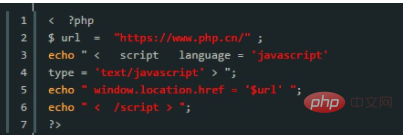Home >Backend Development >PHP Problem >How to jump directly to the page in php
How to jump directly to the page in php
- 藏色散人Original
- 2021-07-23 09:20:0217731browse
How to directly jump to the page in php: 1. Jump through the header() function; 2. Jump through the Meta tag; 3. Jump through JavaScript.

The operating environment of this article: windows7 system, PHP7.1 version, DELL G3 computer
How to jump directly to the page with php?
Several implementation methods of PHP page jump
● PHP page jump 1. header() function
The header() function is used to perform page jump in PHP A very simple way to jump.
The main function of the header() function is to output the HTTP protocol header (header) to the browser.
The header() function is defined as follows:

The optional parameter replace indicates whether to replace the previous similar header or add a header of the same type. Default is replace.
The second optional parameter http_response_code forces the HTTP corresponding code to the specified value.
The Location type header in the header function is a special header call, often used to implement page jumps.
Note:
1. There cannot be a space between location and ":", otherwise it will not jump.
2. There cannot be any output before using the header.
3. The PHP code after the header will also be executed.
The code is as follows:

● PHP page jump 2. Meta tag
Meta tag is responsible for providing document meta-information in HTML Tag, using this tag in PHP program can also realize page jump.
If http-equiv is defined as refresh, when the page is opened, it will jump to the corresponding page within a certain period of time based on the value specified by the content.
If content="seconds;url=website" is set, it defines how long it will take for the page to jump to the specified URL.
The code is as follows:


PHP Video Tutorial"
The above is the detailed content of How to jump directly to the page in php. For more information, please follow other related articles on the PHP Chinese website!

